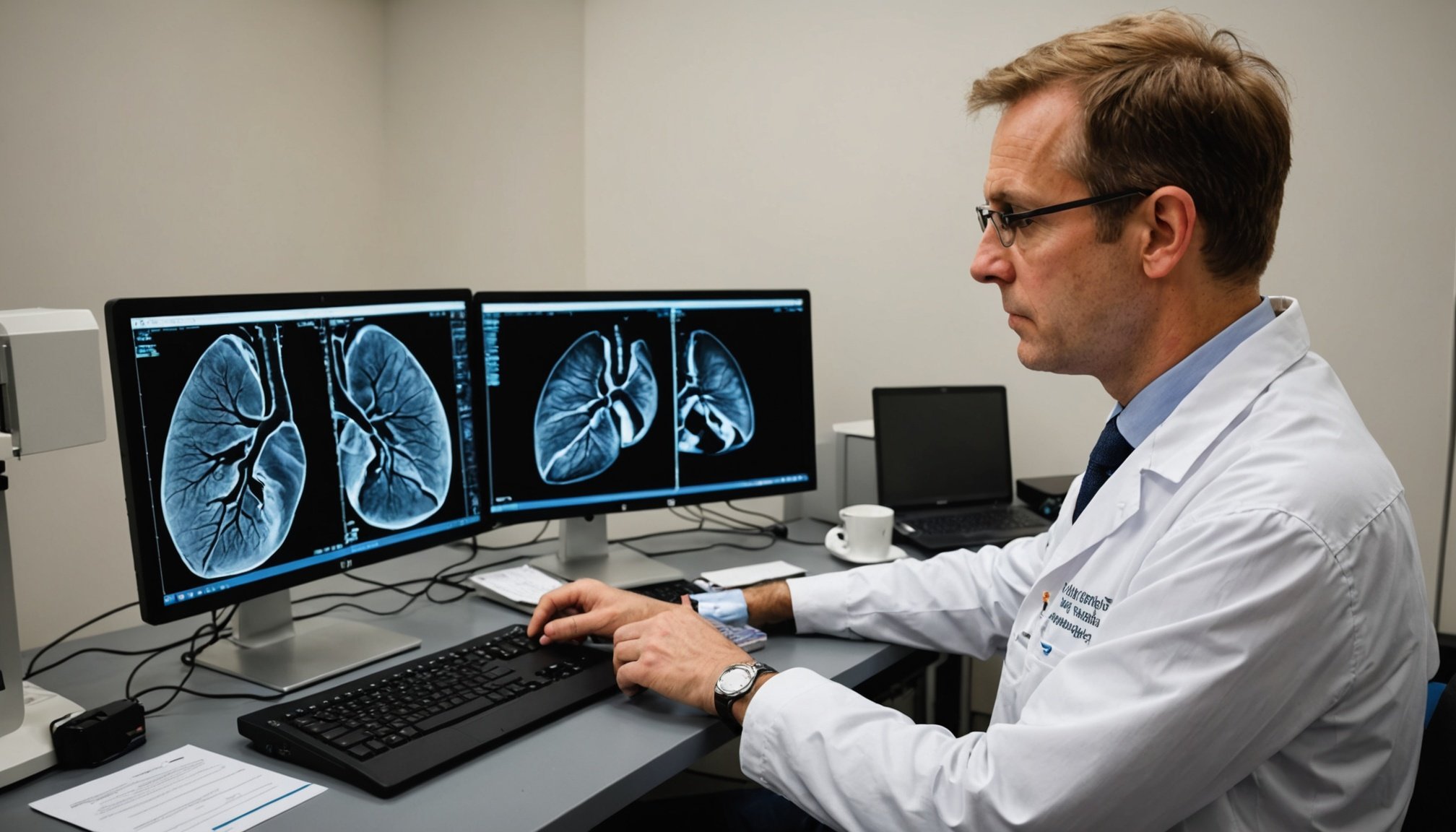Overview of Lung Fibrosis
Lung fibrosis, known scientifically as pulmonary fibrosis, represents a condition wherein the lung tissue becomes damaged and scarred. This thickening of lung tissue can hinder its ability to function normally, leading to compromised breathing. Understanding lung fibrosis is crucial, as it is a progressive disease where symptoms can gradually worsen over time. Initial symptoms often include persistent dry coughs and shortness of breath, especially after physical activity. As the condition advances, individuals may experience fatigue, unexplained weight loss, and even clubbing of fingers—an abnormal rounding of the nail bed.
Understanding potential causes of lung fibrosis is vital for early detection and management. Although the exact cause of the scarring can sometimes be idiopathic (unknown), several risk factors have been identified. These include prolonged exposure to environmental pollutants, like asbestos or silica dust, certain medical treatments such as radiation or chemotherapy, and lifestyle choices like smoking. Genetic predispositions and autoimmune diseases, like rheumatoid arthritis, can also lead to lung fibrosis. Recognising the symptoms early on and identifying potential causes can significantly aid in managing the progression of lung fibrosis and formulating effective treatment plans.
In parallel : Empowering Patients: Strategies for UK Audiologists to Combat Noise-Induced Hearing Loss in Industrial Environments
Significance of Early Detection
Identifying conditions early, such as lung fibrosis, can immensely improve patient outcomes. The early detection process allows for timely intervention, optimising treatment effectiveness. When lung fibrosis is identified in initial stages, the prognosis tends to be considerably better compared to diagnosis at later stages. Patients benefit through a wider range of treatment options tailored to manage the condition effectively.
Impact on Prognosis
Studies consistently show that early diagnosis significantly heightens the chances of positive patient outcomes. For instance, when lung fibrosis is detected early, there is a marked improvement in survival rates and overall quality of life.
Statistical Outcomes
Statistics reveal a stark contrast in outcomes between early and late detection. Patients diagnosed early with lung fibrosis have approximately a 30% higher probability of stabilising their condition compared to those detected at later stages. This variance in outcomes underscores the absolute necessity of prompt detection.
Influence on Treatment
Early detection also directly impacts treatment strategies. It enables healthcare providers to initiate less aggressive, yet highly effective, treatment plans. Moreover, patients diagnosed early can maintain a better quality of life, experiencing fewer symptoms and enjoying greater longevity. Early action remains pivotal in altering the course of lung fibrosis.
Cutting-Edge Diagnostic Techniques
Exploring the realm of diagnostic techniques, particularly advanced imaging, showcases an evolution in how we approach and understand pulmonary conditions like lung fibrosis. Modern technology has propelled imaging forward, integrating innovative tools that enhance precision and clarity.
Advanced imaging technologies such as high-resolution computed tomography (HRCT) offer unprecedented insight, allowing for detailed views of lung structures. With such advancements, subtle changes indicative of lung fibrosis can be identified much earlier, improving treatment outcomes. The role of biomarkers in the early detection of lung fibrosis is paramount. These biological indicators, often detected through imaging and laboratory tests, serve as critical early warning signals, ensuring timely intervention and management.
Moreover, artificial intelligence (AI) is revolutionizing the diagnostic landscape. By processing vast datasets, AI algorithms can identify patterns that may not be immediately apparent to human eyes, enhancing the accuracy of lung fibrosis diagnoses. The integration of AI in diagnostic techniques allows for the simultaneous analysis of multiple imaging modalities, streamlining the diagnostic process and minimising error.
Together, these advances in technology provide a comprehensive, precise, and proactive approach to diagnosing pulmonary conditions, highlighting a promising future in medical diagnostics.
Comparisons with Traditional Methods
When diagnosing lung fibrosis, traditional methods often include techniques like X-rays and pulmonary function tests. These assessments have been widely used due to their availability and cost-effectiveness. However, they possess significant limitations in providing accurate early-stage detections. Conventional X-rays might not catch the subtle changes in lung structures indicative of early fibrosis due to their lower diagnostic accuracy.
In contrast, advanced techniques such as high-resolution CT scans offer a comparative advantage by revealing more detailed images of the lung tissue. These modern techniques can identify fibrotic changes much earlier, enabling timely intervention and management, thus improving patient outcomes.
However, it’s important to note that these advanced methods may come with higher costs and require specialized equipment, which might not always be available in all medical facilities, particularly in resource-limited settings. Despite this, the precision and early detection capabilities of advanced diagnostic approaches make them essential tools against the backdrop of the inherent limitations found in traditional methods. Consequently, integrating these techniques could substantially improve the effectiveness of diagnosing and treating lung fibrosis.
Expert Insights and Case Studies
Exploring advancements in the field of pulmonology requires insights from leading experts and practical evaluations through case studies. As we look into the noticeable trends in clinical practice, it is crucial to draw from experiences and testimonies in the field.
Expert Testimonies
Leading pulmonologists in the UK have provided their expert opinions on cutting-edge approaches within pulmonology. One esteemed practitioner emphasized the significance of early lung fibrosis detection, illustrating how improvements in imaging techniques have drastically influenced diagnostic accuracy. These opinions underscore the importance of integrating scientific advancements into everyday clinical practice.
Successful Case Studies
In recent case studies, hospitals across the UK have implemented innovative treatments with remarkable success. For instance, one health institution reported an increase in patient survival rates following the adoption of a novel method for treating chronic lung diseases. Such examples not only confirm the effectiveness of these techniques but also highlight their practical benefits when applied in real-world settings.
Emerging Trends in Pulmonology
The field has seen significant contributions from leading pulmonologists, pushing towards groundbreaking trends in the early detection of lung fibrosis. Recent data indicates an increasing reliance on AI technologies within clinical practice, enhancing early diagnostic capabilities and potentially changing the landscape of patient care. Through ongoing innovation and application, these trends promise to reshape pulmonology’s future trajectory comprehensively.
Ongoing Research and Future Directions
Current research initiatives in lung fibrosis diagnostics are focusing on enhanced imaging techniques and genetic profiling. These efforts aim to improve the accuracy and timeliness of diagnoses, potentially revolutionising the field. Advances in technology could lead to non-invasive methods replacing traditional biopsies. As these technologies develop, they promise increased accessibility and precision in detecting lung fibrosis.
Clinical trials play a critical role in evaluating new diagnostic tools and methodologies. They assess the effectiveness and safety of innovations, ensuring they meet medical standards before widespread implementation. These trials are fundamental in adapting practices in pulmonology, as they provide evidence of efficacy.
Looking ahead, several future trends could redefine the landscape of lung fibrosis diagnostics. Machine learning and AI technologies promise to enhance the predictive power of diagnostic tools by analysing vast datasets swiftly. Early detection will become more achievable with advanced algorithms, offering patients more targeted treatment options sooner. Moreover, personalised medicine approaches, facilitated by genetic research, hold promise for tailoring strategies to individual patient needs.
These ongoing research efforts underscore the dynamic landscape of medical advancements, highlighting the importance of continuous innovation and clinical validation in improving health outcomes.











